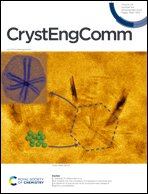Study on the luminescence properties of ionic [Cu(N^N)(P^P)]+ complexes: influence of ligands, counteranions and weak interactions†
Abstract
Herein, a series of ionic mononuclear Cu(I) complexes, [Cu(phen)(bdppmapy)]Cl (1a), [Cu(phen)(bdppmapy)]Br (2a), [Cu(phen)(bdppmapy)]I (3a), [Cu(phen)(bdppmapy)]SCN (4a), [Cu(Dpq)(bdppmapy)]Cl (1b), [Cu(Dpq)(bdppmapy)]Br (2b), [Cu(Dpq)(bdppmapy)]I (3b) and [Cu(Dpq)(bdppmapy)]SCN (4b) {phen = [1,10]phenanthroline; Dpq = pyrazino[2,3-f][1,10]-phenanthroline; bdppmapy = N,N-bis((diphenylphosphino)methyl)-2-pyridinamine} have been synthesized and characterized by using IR, NMR, elemental analysis, single crystal X-ray diffraction analysis, fluorescence spectroscopy methods, and UV-vis and terahertz (THz) time-domain absorption spectroscopy. Their crystal structures were elucidated by X-ray crystallography and their photophysical properties were investigated in detail. All the above complexes exhibit a 1D to 3D supramolecular structure which is linked together by intermolecular weak interaction forces and hydrogen bonds. By regulating ligands and anions, the emission wavelengths of these complexes are quite different in the range from 533 nm to 604 nm. Theoretical calculations and photophysical properties indicate that luminescence is derived from metal-to-ligand charge transfer (MLCT) excited states. In the meantime, the results of calculations show that the stabilization of the increased conjugation of the ligand-based π* orbital is ascribed to the observed bathochromic-shift in the MLCT transitions.
![Graphical abstract: Study on the luminescence properties of ionic [Cu(N^N)(P^P)]+ complexes: influence of ligands, counteranions and weak interactions](/en/Image/Get?imageInfo.ImageType=GA&imageInfo.ImageIdentifier.ManuscriptID=D2CE01177H&imageInfo.ImageIdentifier.Year=2022)


 Please wait while we load your content...
Please wait while we load your content...